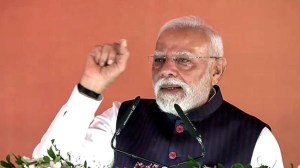Saint, Sinner, Seller, Showoff
The Kumbh Mela is called the largest congregation of humanity on a single spot on Earth.

The Kumbh Mela is called the largest congregation of humanity on a single spot on Earth. While its half-brother, the Ardh Kumbh Mela, doesn’t stack up as impressively when it comes to head count, its mystique and divinity are no less a magnet to millions of Indians.
Much before you reach the bend in the river where the Ganga embraces the Yamuna, what catches the eye are the tents. Steepled cones of cloth laid out in rows, these are the half-houses of the itinerant. Sinner and saint, beggar and baron, pilgrim and priest huddled in blankets, as they wait out the march to dawn.
Giving them company are countless glistening spotlights that tear the darkness with their stabbing, probing eyes. And night, like the demons that had stolen the kumbh or urn containing the holy nectar from the gods, had been vanquished for the moment.
As I climbed the last sandy steps of the embankment overlooking the Sangam on Makar Sankranti, I was touched by a feeling that I couldn’t quite explain.
Faith moves people in mysterious ways. Perhaps, the strangest of them all are the self-anointed sons of the Ganga — the Naga sadhus. Clad only in the skin of their bodies and the smear of ash, they dance to a piper we cannot hear or see. Fiercely protective of their wild ways, the trident in their hands is both sceptre and stave.
Beware those who cross their path: a painful blow is what they can expect.As they stomp down the sand-carpeted path to the ghats, the Naga sadhus form a vision that is likely to haunt you forever — the arrogance that has its darker manifestations, the pride that has dared to bare all and the righteousness that demands the world take its rightful position at their feet.
At the appointed time when the sun flecked the waters, they came charging into their river with fearsome whoops and cries. And once the sacred ablutions on their three-pronged spears were done with at the Shahi Snan, they departed as abruptly as they had come.
A day later, I saw novice monks all lined up subserviently to get their heads tonsured: a ritualistic preface for conducting the pind daan rituals normally carried out at one’s death. This was their graduation ceremony to Nagahood!
IT is with good reason that the Ardh Kumbh is called a mela, for the sideshow to the faithful is a mélange of the magical—bangles on hoops inviting attention, mounds of vermilion and saffron powder, toy helicopters spinning excitedly through the air, flashing life-sized robots doubling as weighing machines, syrupy sweetmeats with greedy clouds of flies and yes, even a Bhuley Bhatkey shivir reminiscent of Bollywood.
Ambling around the ghats, I marvel at the ease with which the modern world coexists with the ancient. It was not out of place to see a sadhu discovering the joys of a digital camera, or a turbaned villager drawing money from an ATM-on-wheels. As for the river, it was dotted with boats sloughing through the waters with sun covers displaying the Hutch dog-and-boy advertisement.
Of exotica, there is plenty. Curious crowds milled about the baba who’d kept his right arm raised for 27 years at a stretch. A devotee drew his share of stares, for one side of his face had a freakish growth of flesh resembling a Ganesha in repose! But far more amazing than these were the pilgrims themselves, who stoically camp out the cold nights to attend a call that has been passed down from generations.
With the sun now just a hazy afterthought on the evening of Mauni Amavasya, celebrated on Friday, making it the most auspicious day in the six-week-long festival, I put the camera back in its case.
If ever one could hope for a new beginning, it was at this holy confluence of two mighty rivers. Where India stood on the edge, and then waded in to heal herself of an age that was past and done.





- 01
- 02
- 03
- 04
- 05


























